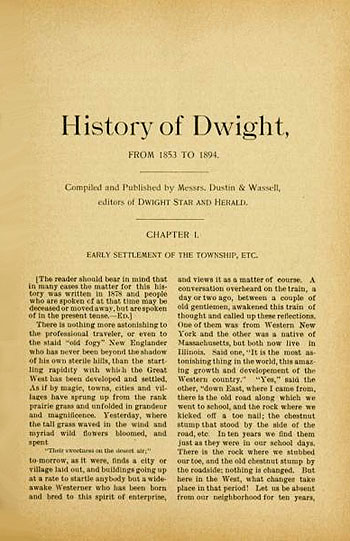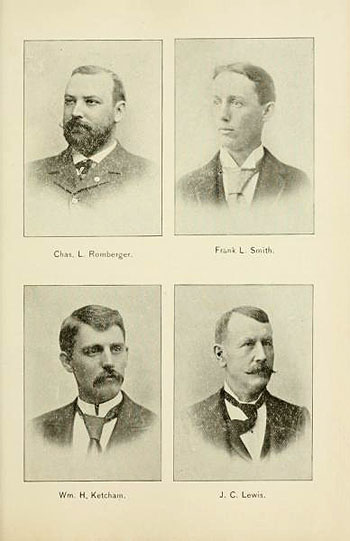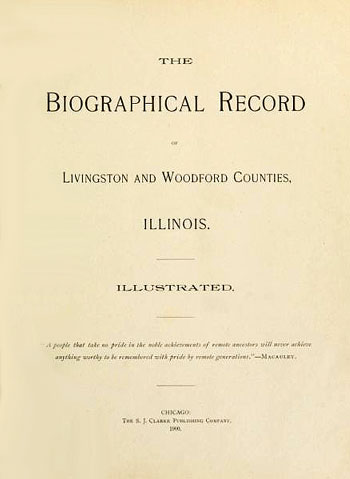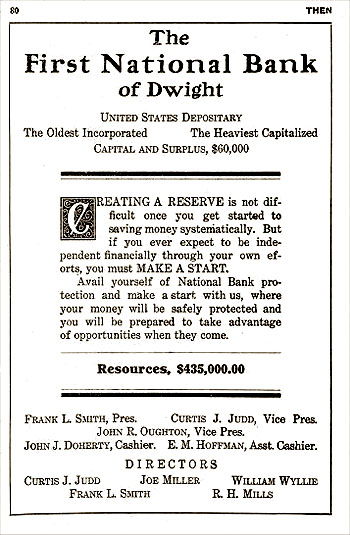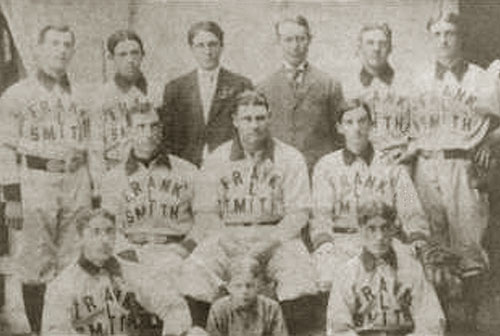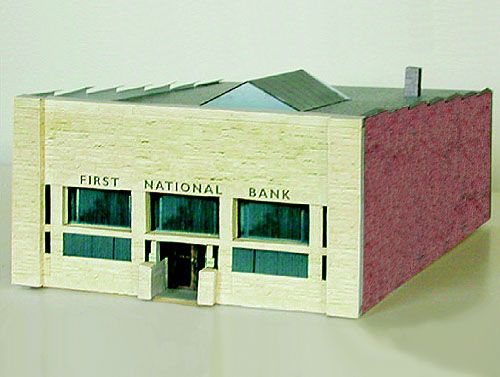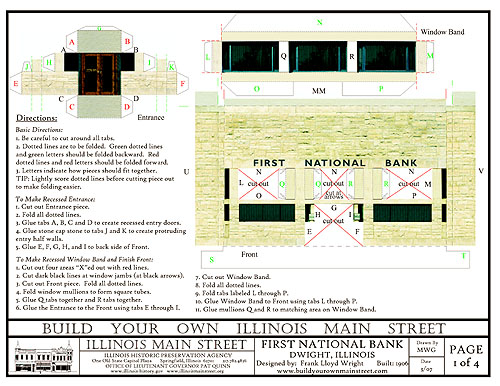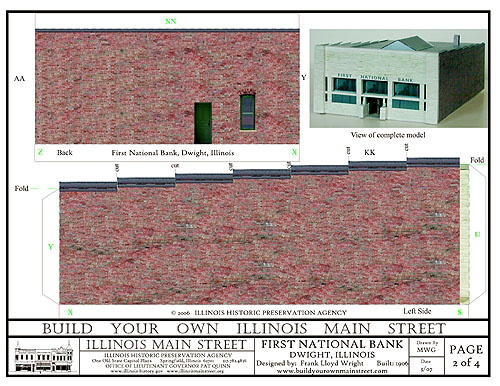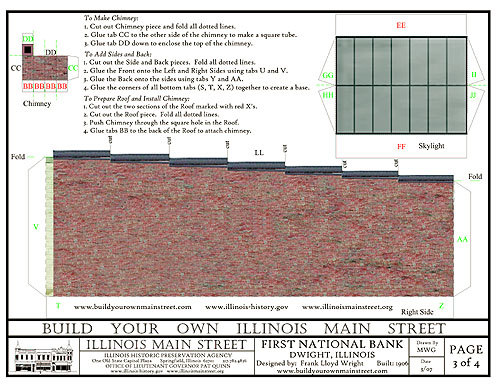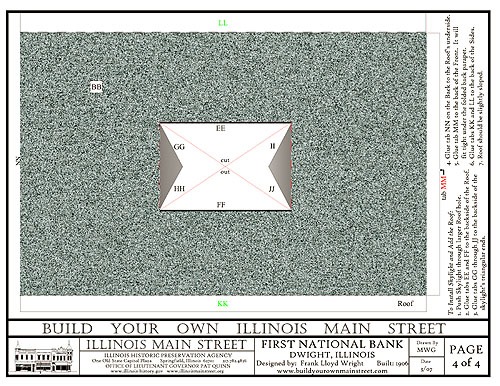
SUPPORT THE
WRIGHT LIBRARY
PROCEEDS FROM EVERY SALE GOES TO SUPPORT THE WRIGHT LIBRARY.
CLICK TO ORDER.
WE PROUDLY SUPPORT THE FRANK LLOYD WRIGHT FOUNDATION

WE PROUDLY SUPPORT THE FRANK LLOYD WRIGHT BUILDING CONSERVANCY
WE PROUDLY SUPPORT FALLINGWATER
AND THE WESTERN PENNSYLVANIA CONSERVANCY
- Wright Studies
- Frank L. Smith Bank, Dwight, Illinois (1905 - S.111)
History of Dwight, From 1853 to 1894
Compiled and Published by Messrs. Dustin & Wassell, editors of Dwight Star and Herald
1894
. Page 1 Page 65: (Top) Chas. L. Romberger, Frank L. Smith
(Bottom) Wm H. Ketcham, J.C. Lewis (Circa 1894)Note: Romberger and Ketcham were two of Smith's associates. CHAPTER IX. 1893.
Excerpt from Page 98:Miss Minnie Ahern and Frank L. Smith are married Feb. 8. The night before Mr. Smith was tendered a reception at the Scott House by many of his bachelor friends.
BIOGRAPHICAL RECORD 1900
The Biographical Record Of Livingston and Woodford Counties, Illinois
Published By The S. J. Clarke Publishing Company
Chicago, 1900
The Biographical Record Of Livingston and Woodford Counties, Illinois
Published By The S. J. Clarke Publishing Company
Chicago, 1900COLONEL FRANK L. SMITH CHARLES L. ROMBERGER WILLIAM H. KETCHAM, JR.
Excerpt from Pages 33-34:
COLONEL FRANK L. SMITH (Photograph)
Colonel Frank L. Smith, of Governor Tanner's staff, is one of the leaders of the Republican party in Livingston county, his large acquaintance and unbounded popularity giving him an influential following, while his shrewd judgment of men and affairs make his counsel of value in all important movements. In business circles he also takes a foremost rank, his success as a real estate dealer being all the more notable from the fact that it has been secured by his own judicious management.
This prominent citizen of Dwight, a member of the well-known firm of Romberger & Smith, was born in that city November 24, 1867, and is a son of Jacob J. and Jane E. (Ketcham) Smith, natives of Germany and New York, respectively. The father was only four years old when brought to America by his parents, who located in Pennsylvania, but at the age of fifteen he came to Dwight, Illinois, which continued to be his home until 1891, when he removed to Chicago, where he died in 1894. His wife died nine years previous. In their family were three children.
Colonel Smith received his early education in the public schools of Dwight, and at the age of seventeen taught school in Round Grove township for about one year, after which he accepted a position in the freight department of the Chicago & Alton Railroad at Dwight, remaining with them in a clerical capacity about four years. In 1887 he went to Chicago and accepted a similar position with the Rock Island Railroad, being located at the Englewood station two years. Subsequently he served as cashier with P. H. Bolton & Company, commission merchants on South Water street, Chicago, until 1890, when he returned to Dwight and entered into partnership with W. H. Ketcham (possibly his cousin) in the real estate and loan business. When that firm was dissolved April I, 1895, Colonel Smith became connected in business with C. L. Romberger under the name of Romberger & Smith, their specialty being real estate and real estate work, although they do a private banking business for the accommodation of friends and acquaintances. Without question the firm does one of the largest loan and real estate businesses in central Illinois, this fact being conceded by all other firms in their line. At present they are extensively interested in Mississippi and Louisiana lands. Their holdings in the latter state are timber lands, which the firm purchased with the view of enhancing their value, and in January, 1900, they sold one tract of twelve thousand acres in Madison parish. This is desirable property, being accessible to steamboats and the Vicksburg, Shreveport & Pacific Railroad. The Mississippi land is in the Delta country, and is also covered with hard wood timber, principally oak, pecan and gum. When cleared this will become excellent cotton land. Besides this property, the firm has about fifteen hundred acres of fine farming land in Lee county, Illinois, which is well improved and under a high state of cultivation, and also operate largely in Iowa and Indiana lands.
On the 8th of February, 1893, Mr. Smith was united in marriage with Miss Minnie Ahern, of Dwight, a daughter of John and Margaret Ahern. who are at present living in Ogden, Utah. Mrs. Smith is a member of St. Patrick's Catholic church, of Dwight, and the Colonel belongs to Hebron lodge, No. 73. K. P., and Dwight Camp, M. W. A. Since attaining his majority he has affiliated with the Republican party, and has taken a very active and prominent part in political affairs, always attending the county conventions and serving as a delegate to the state conventions three times. In the spring of 1900 he was offered the nomination for state senator on his party ticket, but would not accept on account of his business interests, though the nomination was equivalent to an election in his district, which is strongly Republican. Early in his career he served as city clerk in Dwight, but since then he has never been prevailed upon to accept office. In January, 1897, he was appointed colonel on Governor Tanner's staff, and in that capacity has participated in many important functions, being present at the inauguration of President McKinley at Washington. D. C. in March, 1897: the unveiling of the Grant monument at New York; the unveiling of Logan's monument at Chicago ; the christening of the battleship Illinois at Newport News, Virginia; and the dedication of the Illinois monument at Chattanooga, Tennessee.Excerpt from Pages 60-61:
CHARLES L. ROMBERGER (Photograph)
...In 1884, at the suggestion of Hon. Walter Reeves, now member of congress from this district, Mr. Romberger came to Dwight and opened a law office over the People's Bank, being alone in business until 1887, when he formed a partnership with John C. Hetzel, a real estate and insurance agent, under the firm name of Hetzel & Romberger. In 1891 he bought out his partner and continued alone until November, 1895, when he sold a half interest in the business to Frank L. Smith, the firm being known as Romberger & Smith. Their specialty is real estate and real estate work, although they do a private banking business for accommodation of friends and acquaintances. Without question the firm does one of the largest loan and real estate businesses in central Illinois, this fact being conceded by all other firms in their line. At present they are extensively interested in Mississippi and Louisiana lands. Their holdings in the latter state are timber lands, which the firm purchased with the view of enhancing their value, and in January. 1900, they sold one tract of twelve thousand acres in Madison parish. 1 his is desirable property, being accessible to steamboats and the Vicksburg, Shreveport & Pacific Railroad. The Mississippi land is in the Delta country and is also covered with hardwood lumber, principally oak, pecan and gum. When cleared this will become excellent cotton land. Besides this property the firm has about fifteen hundred acres of fine farming land in Lee county, Illinois, which is well improved and under a high state of cultivation, and also operates largely in Iowa and Indiana lands. Since coming to Dwight Mr. Romberger has had complete charge of the Keeley Company's legal business, and is attorney for the estate of Dr. Leslie E. Keeley. He is also local attorney for the Chicago & Alton Railroad. He does very little court work, however, his entire legal business being confined to office practice. He is interested in the Keeley Institute, located at No. 2803 Locust Street, St. Louis, Missouri, being a partner of Dr. J. E. Blaine, who for eight years was chief of the medical staff of the Leslie E. Keeley Company of Dwight.Excerpt from Page 164
WILLIAM H. KETCHAM, JR. (Photograph)
William H. Ketcham, Jr., was reared and educated in Dwight, and began his business career as bookkeeper in the grain elevator of Hugh Thompson, of that place, remaining with him one year. He then became interested in the stock business, which he carried on alone for one year, buying cattle in Livingston and Grundy counties. At the end of that time he formed a partnership with John Thompson in the same business, shipping stock to the Chicago market. This connection lasted two years, and Mr. Ketcham next purchased the real estate business of Alexander McKay, which he conducted from December, 1886, until April, 1887, when he sold out to Hetzel & Romberger.
After disposing of his real estate business, Mr. Ketcham moved to Marion county, Kansas, where he was interested in the same pursuit until the fall of 1887, when he entered the law office of Kellar & Dean, studying under their instruction and at the same time doing office work. Before his admission to the bar he drew up the papers for twenty-one foreclosures in one week. He was admitted to practice by examination before Judge Doster, the present chief justice of the state of Kansas, August 20, 1888, and before the supreme court at Topeka, June 2, 1891. He was associated in practice with W. H. Carpenter, of Marion, Kansas, from 1889 to July, 1891, when he returned to Dwight and resumed business as a real estate dealer, in partnership with Frank L. Smith, under the firm name of Ketcham & Smith. On the 23d of March, 1892, he was admitted to practice in Illinois, and later in the state of Indiana. By mutual agreement the partnership between Mr. Ketcham and Mr. Smith was dissolved in October, 1895, since which time our subject has been alone in business. He gives the greater part of his attention to real estate, but is also engaged in the practice of law in the courts of this state and Indiana. He carried the Clauson case through the supreme court of Illinois.DWIGHT STAR AND HERALD 1906
FIRST NATIONAL BANK OF DWIGHT
Published in the Dwight Star and Herald, Feb. 3, 1906.
The article included pictures of the exterior of the bank and of its founders and a short biographical note on each of the founders.
"The building is brick on concrete foundation and with a front of buff Bedford or colitic lime stone, rough faced except at the openings.' The front is novel in that the windows are very broad, and instead of a single large, square window, there are two rectangular windows separated by a massive stone lintel. This arrangement permits the maximum floor space within the building and yet gives the appearance of great thickness to the front wall of the building. The building impresses one with its solidity and permanency.
"The entrance is in the center of the building and is guarded on either side by lanterns with massive pedestals. On entering the building, one passes into the loggia, floored with concrete and wainscotted with stone, above which are broad plate glass windows looking into the office on one side and the bank room on the other. At the end of the loggia are the doors, one into the bank room and one into Col. Smith's offices.
"Within the bank door is the bank lobby surmounted by a very simple but attractive skylight which affords light for the lobby and also for the bank workroom. On the left of the lobby is a large bank counter of simple, quiet design, in harmony with the rest of the building. At the left of the bank counter in the front of the building is the officers' desk, which, is divided from the other part of the room by a railing. At the right end of the bank counter' is a very heavy and substantial vault, upon which much thought has apparently been placed. In the arrangement of the vault, its position and construction, the latest ideas for protection and security have been sought and achieved. The vault rests on very deep solid concrete foundation and is constructed of concrete, reinforced with iron, and so located that all sides of the vault are visible both night, and day, and cannot be approached by burglars without their being seen. Inside the vault is one of the latest and best money chests that can be found. This is provided with a triple time lock and with formidable machinery which forces the outer door into the safe so tightly that it will be impossible for the safe to be opened by dynamite as is customary with yeggmen and burglars. Inside this time locked door are two other doors, equally as thick and in turn provided with combination locks, so that a person outside the bank desiring to reach the contents of the money chest would have to force four separate doors before arriving at his goal; first, to get into the bank, then to get into the vault, then to get through the outer doors of the safe and then through the inner doors. The vault door besides being a massive structure is also further protected by a day gate which closes automatically and gives an alarm every time anyone moves it, so that it will be impossible for sneak thieves or other persons to enter the vault in the day time without the same being known.
"Back of the bank room is the directors' room furnished with solid, simple furniture in keeping with the rest of the building. Anyone entering the building is struck with the idea that the same is conceived on a broad, substantial, yet very simple plan."There are several unique features in this building due to the fact that the same is designed for a special purpose: one of these is the president's room which commands a view of both the bank lobby and the real estate side of the building; another is the use of stone pillars to support the roof and which give one rather a novel impression; another is the openness of the building due' to the fact that in nearly every partition are the horizontal windows which not only add to the appearance of the rooms but give to them the effect of a greater size than they in reality have. There is another unique feature, and that is there is no basement in the building, that instead of a basement is a thick coating of cinders upon which is laid a concrete floor and on top of this floor is what is known as monolith, being a floor constructed similar to concrete cut made out of sawdust and cement, and therefore being somewhat like linoleum in its feeling, although firmer and more durable.
"Leaving the president's room which is in the middle of the rear of the building, one enters the private office which was designed for and is to be occupied by Mr. Ludington. This likewise commands a view of the main office and at the same time is perhaps the most private room in the building. Opening off Mr. Ludington's room is the telephone and toilet room out of which runs a commodious vault designed to protect from fire the valuable papers belonging to Col. Smith's business.
"In front of Mr. Ludington’s office is the main office which many will think is the handsomest room in the building. It is a large square room lighted by a handsome skylight, and on three sides with windows opening into other rooms of the building and commanding a view in all three directions, and on the fourth side is the magnificent bookcase filled with, the law library."In front on the office side is the agent's room which is a large and light private office.
''One thing which strikes the observer is the harmony in the color scheme: floors, walls, woodwork and ceiling, while differing in degree are yet not a difference in kind sufficient to form a marked contrast. The furniture and trim of the building is all of the same wood and of a similar finish, designed to fill the requirement and at the same time give the least possible surface for collecting dust. There are no arches, curves, circles or crooks in either furniture or building, as everything is built on the square. The decoration of the walls has a quiet dignity. Up to a height of seven feet, they are of a dull olive green, above that of yellow sand color. The yellow idea is further carried out in the fixtures which are of lemon colored brass and which are perhaps only noticeable for their simplicity. In fact, simplicity and strength are the dominant characteristics of the building; and as it is said to be true that persons partake of their environment, it will apparently mean that the business which is carried on and built up in this building will have strength and durability which will be of inestimable value in the community.
"There is another unique feature of the building which has not been mentioned and that is the fact that there is no rear entrance, all openings in the rear being protected by strong gratings so that all business must come through the front door; and while the rear of most buildings is1anything but pleasing to look at the First National Bank building is an exception to this rule, for although it is plain brick, the design shows the same characteristic thoroughness, solidity and simplicity of treatment that is shown in the front of the building."One cannot leave the building without carrying with him a picture of very beautiful furniture which is so in harmony with the building itself it is easily recognized as being the conception of the same mind as that which designed the building. There is nothing ornate or useless in the furnishings and although they were designed strictly for usefulness, they have a beauty which cannot but attract even the casual observer. In both the bank lobby and the main room of Col. Smith's offices are inviting seats provided with leather cushions which make them as attractive in reality as they appear. There is a smaller seat likewise in the office of Col. Smith, and it is in this room that there is a touch of luxury evidenced by a very comfortable Morris chair standing by an open fireplace which latter is so simple and unobtrusive that one hardly suspects its true character at first glance. The Roman brick of which the fireplace is constructed, and which in fact covers the entire end of Col. Smith's room, adds a touch to the color scheme not found in the other rooms of the building.
"The building and furniture are after plans and arrangements prepared by R. S. Ludington after considerable study of the requirements of the business.
"Frank Lloyd Wright, of Chicago and Oak Park, is the architect of the building and the designer of the fixtures and furniture, and by his work he has demonstrated his ability as a master architect who can do things that are not only original but are also practical and beautiful."Published in the Dwight Star and Herald, Feb. 3, 1906. Back FIRST NATIONAL BANK AD 1908
FRANK L. SMITH FOR GOVERNOR, 1916
Frank L. Smith For Governor.
1916 Political Campaign Pin
According to Carroll Hill Wooddy, “The Case of Frank L. Smith”, the ruling ambition of Smith was to be governor of Illinois. A Representative and Senator-elect from Illinois; Dwight village clerk 1894; unsuccessful candidate for lieutenant governor 1904; internal-revenue collector 1905-1906; elected as a Republican to the Sixty-sixth Congress (March 4, 1919-March 3, 1921); was an unsuccessful candidate for the Republican nomination for United States Senator; chairman of the Illinois Commerce Commission 1921-1926; appointed as a Republican to the United States Senate in 1926 to fill the vacancy caused by the death of William B. McKinley in the term ending March 3, 1927; presented credentials as a Senator-designate but was not permitted to qualify, presented credentials as a Senator-elect to the United States Senate for the term beginning March 4, 1927, but again was not permitted to qualify and subsequently tendered his resignation on February 9, 1928; unsuccessful candidate for election in 1930 to the Seventy-second Congress; member of the Republican National Committee in 1932.Page 84 indicates that “In spite of the the sarcastic attitude of the newspapers toward his gubernatorial boom, Smith hoped that 1908 would be a favorable year for pressing his pretensions. No strong Chicago candidate appeared, however, to divide Deneen's vote in the metropolis, and Smith reluctantly abandoned the idea of running for the "real job”.
Page 91-92:
Smith’s eyes were still fixed on the governorship…
As early as December, 1914, it was known that he was a prospective candidate, and in March 1915, his formal announcement was made public.Page 94-95:
…Not until mid-July 1916, …and with less than two months remaining before the primary the campaign settled down to a three-cornered race between Lowden, Smith and Hull, the minor candidates having by this time been eliminated.
Opening his campaign, Smith stressed his record as a business man…
His own congressional district went substantially for him, but outside of this home territory he made but a slight impression.
Smith doubtless knew long in advance that his defeat was certain and when the returns were known he reconciled himself to the situation to the best of his ability… Sending his congratulations to the victor, he threw himself whole-heartedly into the campaign for the latter’s election.
It should not be assumed, however, that his longing for office was in any way diminished…This political pin was produced in 1915 as part of his run for 1916 race for Governor.
DWIGHT CENTENNIAL 1954
Inside Front Cover:
THE FIRST NATIONAL BANK OF DWIGHT
DWIGHT, ILLINOISIN THE EARLY PART of the year 1905 Col. Frank L. Smith, an enterprising and successful townsman, became interested in the establishment of a National Bank in Dwight. He secured the services of Frank Lloyd Wright, the well-known architect, and arranged for the erection of a handsome stone building, including furniture and fixtures. Mr. Wright, now recognized as the dean of architects in this country and abroad, created a structure that stands as an example of lasting functional planning. The general structure of the building has never been changed since it was originally built, however interior changes were made in order to keep abreast with modern banking conditions and the growth of the institution. The stock was all purchased by local people and the bank started with a $50,000 capital and $5000 surplus. Col. Smith, the president, was the leading spirit in the institution. Other local people who were also interested in the establishment and contributed to the early success of the bank were John R. Oughton, President of the Leslie E. Keeley Company; Major Curtis J. Judd, Treasurer of the Leslie E. Keeley Company; Charles L. Romberger, also an officer of the Leslie E. Keeley Company and a practicing attorney; Joe Miller, a leading merchant and R. S. Ludington, who had just moved to Dwight and also an attorney. According to the records, the Comptroller of the Currency of the Treasury Department of the United States of America reserved the title of "The First National Rank of Dwight" on June 7, 1905 for the persons mentioned above. Shortly after the notice was received from the Comptroller of the Currency, the bank received its charter number, 8044 and was authorized to commence the business of banking as provided in Section fifty-one hundred and sixty-nine of the revised statutes of the United States. The bank has been operating under this charter since the date of organization. The first meeting of the stockholders was held on the 10th day of January, 1906 at which time directors were elected as follows: Frank L. Smith, Charles L. Romberger, Curtis J. Judd, R. S. Ludington and Joe Miller. Immediately following the election of the directors, they held a meeting for the purpose of electing their officers which were as follows: Frank L. Smith, President; Curtis J. Judd, Vice President; John R. Oughton, Vice President and John J. Doherty, Cashier. E. M. Hoffman, the first bookkeeper, is still employed by the bank and now holds the office of president.
PRESENT OFFICERS, DIRECTORS AND EMPLOYEES
OFFICERS: E. M. Hoffman, President James H. Oughton, Jr., Vice President C. J. Ahern, Jr., Vice President Ralph F. Sodini, Cashier R. W. Dempster, Assistant Cashier
DIRECTORS: C. J. Ahern, Jr. E. M. Hoffman Clare R. Mc Namara Martin N. Nelson James H. Oughton, Jr. Richard C. Oughton
EMPLOYEES: Velda T. Erickson, Velda Paulsen, Beverly Weller, Regina Neville, Phyllis Pedersen
Excerpts from Page 24: This page donated by Reeb Monument Works, Ray and Harry's Market, and llruee Reariek
In 1892...
Frank L. Smith announced himself as a candidate for Circuit Clerk.
1895...
On November 15, Charles Romberger and Frank L. Smith formed a partnership for Real Estate and Farm sales.
in 1896...
Frank L. Smith was a candidate for Circuit Clerk. This was the start of his career in politics. The next year he was appointed Colonel on Governor Tanner's staff.
Excerpts from Page 26: This page donated by The Village of Dwight
...On June 7, 1905, the First National Bank of Dwight was organized by Col. Frank L. Smith, John R. Oughton, Major Curtis J. Judd, Charles L. Romberger, Joe Miller and R. S. Ludington. The stone building still standing and the furnishings and fixtures were designed by Frank Lloyd Wright, well known architect.
On October 22, 1907 of that year the Detroit Tigers, American League Champions, going to their farm club at Springfield, stopped off here to play the Frank L. Smith team. On the Dwight team was Cutshaw, Reel, Smith, Donlin, Gleghorn, Higgins, Phillips, M. Brown, and R. Brown. The umpires were very much biased for Dwight, and Ty Cobb got a big kick out of putting a man out at first and having the umpires call him safe.
On Nov. 24th, 1913, the Dwight Country Club was organized with Col. Frank L. Smith as president.
On October 6, 1914 the Dwight Woman's Club came into being with Mrs. Frank L. Smith as President.
In 1918 Col. Smith was elected to the United States Congress to succeed the incumbent Congressman, the Hon. John H. Sterling, who was killed in an auto accident after having received the nomination.
Excerpts from Page 27:
This page donated by Wilder’s Appliance Service, Home Oil Co., and Illinois Valley
In this year (1926) also Col. Frank L. Smith was elected to the United States Senate, however, the next
year his seat was contested, and he was denied a seat.
In 1932 Col. Frank L. Smith became Republican National Committeeman from Illinois, and held this
position for four years.
On August 30, 1950, Col. Frank L. Smith died.
Excerpts from Page 50:
THE GREAT PAST TIME IN DWIGHT
Around 1900 the players were Charles McWilliams, F. L. Smith, Amos Orr, Robert Orr, Charles Durphey, Charles Thole, Ed. Reeb, James Van Emman, Clarence Rabe, Wm. Rabe, Bones Thompson, Frank Snyder, Everett Lewis, Tony Kern, Carl Reumiller, and Charles Reel.
The 1902 team was George Kern, James Burns, James Seabert, Manager, Frank L. Smith, Wm. Smith, Otto Mickelson, Deak Morgan, James Ketcham, Eddie Higgins, Ray Brown, and Mose Brown.
Soon after this (1907), Mr. Frank L. Smith was running for Lt. Gov. of Illinois, and the Dwight team, known as the "Frank L. Smith's" were gone about ten days playing every day in towns like Wenona, Lacon, Peoria, Bushnell, Morris, and elsewhere. Mr. Smith sponsored the team for many years, and the game between Morris and Dwight at the Mazon Fair was always a big attraction.
Excerpts from Page 51:
Pictured above are some of the early members of the local Frank L. Smith baseball team. Left to right, they are: Back row: fielder, Geo. Kern; 2nd base, James P. Burns; manager, James Seabert; Owner, Frank L. Smith; short stop, William Smith; pitcher, Otto Mickelson. Center row: catcher, Deak Morgan; 1st base, James Ketcham; pitcher and fielder, Eddie Higgins. Front row: fielder, Roy Brown; mascot, Kenneth Seabert; 3rd base, Mose Brown. The picture was taken about 1912.
Excerpts from Page 60: THE DWIGHT COUNTRY CLUB
A charter was issued by the Department of State at Springfield, 111., through the Secretary of State Harry Woods on November 24, 1913 to the Dwight Country Club.
On the 26th of December 1913 an organization meeting was held at the I.O.O.F. hall and attended by the following persons ; Edward McWilliams, C. J. Ahern, Dr. F. M. Dondanville, S. Fred Cummings, F. J. Vickery, J. L. Van Eman, Rev. F. F. Farrington, Roy V. Seymour, Jos. A. Diefenbach, James E. Seabert, Frank L. Smith and John J. Doherty.
The acting chairman was appointed and Edward McWilliams was appointed and the following officers were elected: Frank L. Smith, President; Edward McWilliams, Vice President ; John J. Doherty, Secretary-Treasurer.
Charles D. McWilliams, Edward McWilliams, F. J. Vickery, C. J. Ahern, Frank L. Smith, Dr. James H. Oughton, R. A. McClelland and John J. Doherty were elected as a board of directors.
The following were charter members: (Page 61) John P. McWilliams, C. H. Thompson, W. G. Dustin, Edward McWilliams, Charles D. McWilliams, Frank L. Smith, C. J. Ahern, J. R. Oughton, Dr. F. M. Dondanville, F. J. Vickery, Dr. James H. Oughton, J. J. Doherty, James L. Van Eman, S. H. Sondergaard, E. H. Wey, R. A. McClelland and Roy V. Seymour.
Excerpts from Page 61: DWIGHT WOMAN'S CLUB
The Dwight Woman's Club held its first meeting on October 6, 1914, in the home of Mrs. Frank L. Smith, who was the first President. The first year book names the following officers: Mrs. Frank L. Smith, President ; Mrs. C. L. Hamilton, First Vice President ; Mrs. T. E. Barry, Second Vice President; Miss Cora Adams, Recording Secretary ; Mrs. C. J. Ahern, Corresponding Secretary; Mrs. C. W. Myers, Treasurer. The Directors: Mrs. C. H. Barr, Mrs. James Oughton, Mrs. J. W. Baker, Mrs. P. J. Reynolds, Mrs. Charles D. McWilliams.
Excerpts from Page 66: MT. OLIVET CEMETERY
In 1915, a group of ladies organized the Mt. Olivet Cemetery Guild to help finance the necessary work to be done at the cemetery. Mrs. Elizabeth Salzer was elected as President of the Guild and served from April 15, 1915 to April 2, 1946, when she resigned. Mrs. Frank L. Smith was elected Treasurer and served from April 15, 1915 to April 2, 1930, when she resigned.
Page 75:
1854 - DWIGHT CENTENNIAL - 1954
THE HISTORY OF DWIGHT, with its narrative of events and tributes to those citizens who contributed their efforts to its making, would not be complete without a fitting tribute to Colonel Frank L. Smith.
Colonel Smith was born in Dwight on November 24, 1867, and passed away on August 30, 1950, having spent his entire life in Dwight.
At an early age he became a worker and was actively engaged in his life's work until almost the very moment that his long and fruitful life came to an end.
He was always a vital force and exerted a great and wholesome influence in this community in which he lived, in the state and in the nation. For over fifty years he was the outstanding leader in the community.
Colonel Smith not only led, but cooperated in the development of Dwight. He was just as eager to cooperate with someone else's plan for civic betterment as he was eager to push his own plans to a successful conclusion. The citizens of Dwight are still mindful of the achievements of Colonel Smith, in many of which they participated and in many of which they were the personal beneficiaries.
It is fitting that in the History of Dwight the efforts of Colonel Frank L. Smith should be given a place along with those pioneers and their successors who also devoted their best efforts to the betterment of our community.
FRANK L SMITH AGENCY
C. J. AHERN, JR. CLARE R. McNAMARA
Insurance •• Property Management •• Real Estate
FIRST NATIONAL BANK BUILDING •• PHONE 8 •• DWIGHT, ILL.BUILD YOUR OWN 2007
BUILD YOUR OWN ILLINOIS MAIN STREET
ILLINOIS MAIN STREET
ILLINOIS HISTORIC PRESERVATION AGENCY
Springfield, Illinois
FIRST NATIONAL BANK, DWIGHT, ILLINOIS
Designed by: Frank Lloyd Wright Built: 1906
Drawn By MWG, Date 3/07
The First National Bank, Dwight, Illinois
The First National Bank in Dwight was designed in 1906 by famous Prairie-Style architect Frank Lloyd Wright. The Prairie Style horizontal massing of the bank was reinforced by the rustic Bedford limestone blocks and the deeply recessed horizontal windows. When the bank was modernized after the Second World War some of the Wright detailing was covered or removed on the interior. In the 1960’s the bank chose to restore the building back to the Wright era and detailing.
HOME ARTIFACTS AUDIO BOOKS PERIODICALS PHOTOS POSTCARDS POSTERS STAMPS STUDIES ASSISTING ABOUT SLIDE SHOW To donate or pass on information, comments or questions:
steinerag@msn.com
©Copyright Douglas M. Steiner, 2001, 2024





